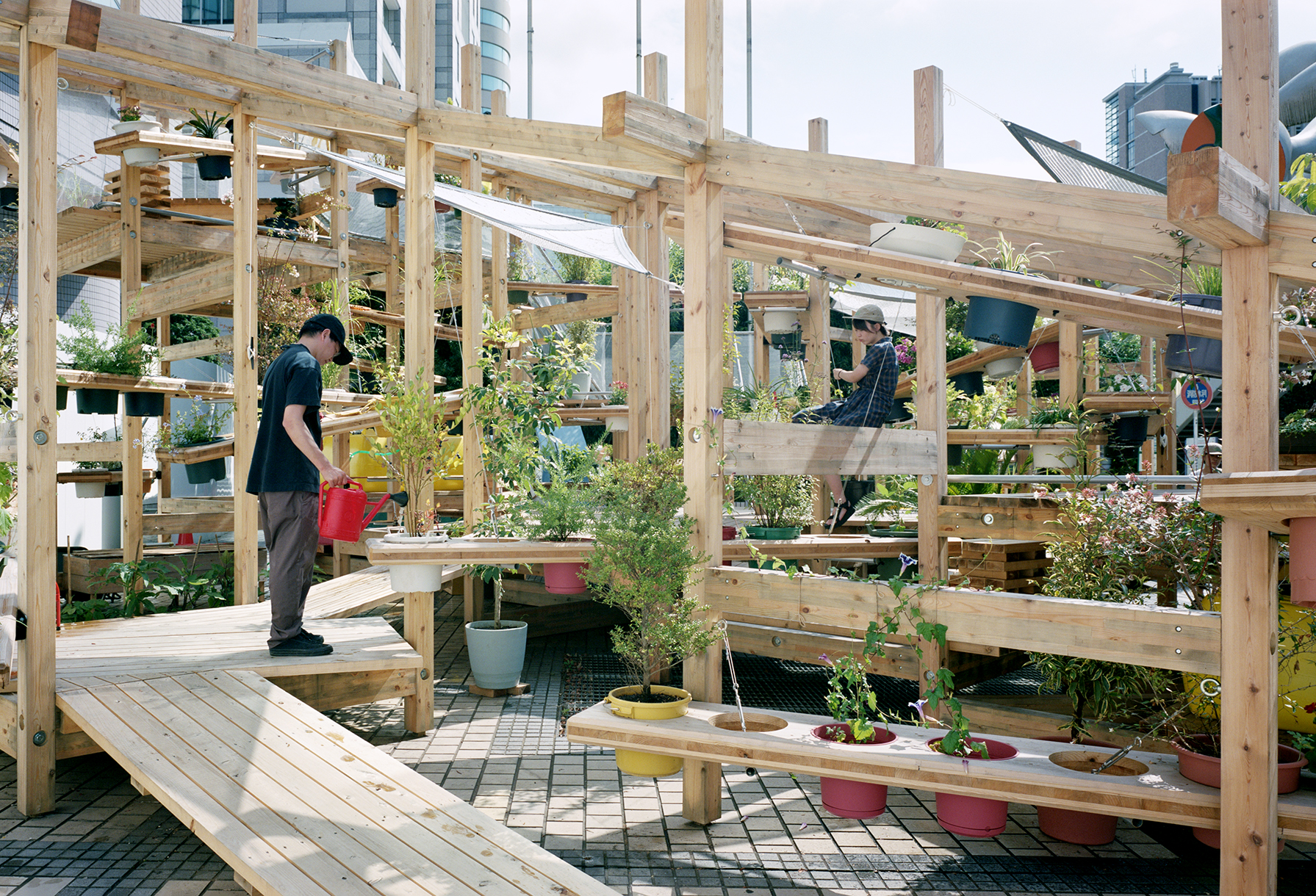STREET GARDEN THEATER
ストリートガーデンシアター
- CULTURE

この1年間で考えたこと
ちょうど1年ほど前、コロナ禍は納まらず、オリンピックの1年延期が決定。パビリオン・トウキョウも2021年に延期されることになった。
単に1年ずれただけでなく、私には世界のバランスがもっと全体的に崩れているようにも感じられた。(例えば、もしもオリンピック自体が中止になったとしても、それが大きい出来事とは多くの人は感じないだろう。)
こうした世界の変化を受けて、私はパビリオンのコンセプトを変えることにした。
ストリートに着目するという着想そのものは変わっていないが、そこに植物の視点、人間以外の存在を加えて考えた。
人間が苦しんできたこの1年、植物はまるで影響を受けていないように見える。人間の活動が弱まったせいか、ずっと家にいるせいか、私は植物に目を向ける機会が以前よりずっと増えてきている。
東京という都市の歴史を植物にこだわって調べていくと、庭が重要な存在であるということがクリアになってきた。江戸時代、大名たちが何百もの屋敷を構え、その屋敷には必ず庭園がつくられた。そのごく一部が、新宿御苑、有栖川公園などの重要な都市公園として残るが、そうした庭園が何千もひしめき合っていたのだから、江戸はまさに「庭の都」「植物の都」だった。
将軍や大名たちだけが、植物を愛でていたかというと、そうではないのが面白いところで、長屋住まいの庶民たちも自分たちだけの庭を育んでいた。
それを可能にしたのが、大名たちの庭を手入れする大量の植木職人たちの出現と、格安の植木鉢の登場、そして江戸の行商文化である。
今も東京では路地裏に入り込むと植木鉢が道や建物を埋め尽くすような風景に出くわすことがある。これは東京という都市が、階級差を越えて庭園を愛でる都市になっていったその歴史の痕跡である。植木は、東京という都市の最小スケールの秩序と言ってもよいかもしれない。
このパビリオンを通じて、東京の植物と道にまつわる物語を提示しようと思う。
東京という都市に脈々と流れる、植物と人間がつくってきた循環的な関係。ローム層の肥沃な土が可能にした、都市の路地裏で農を営む都市。
このストリートパビリオンは、自分たちの日常をたくましく耕し続けてきた東京の市民文化に捧げられた、ひと夏の都市計画として提示される。この都市の文化の根っこが肥大化し、瘤のように隆起した異質空間、位相がずれてしまった世界のバランスを元に戻すのではなく、別の秩序に移行するきっかけになれば面白いと考えている。
藤原徹平
2021年2月23日 二度目の緊急事態宣言下の東京
Just over a year ago, the covid-19 pandemic was not going away and the Olympics were postponed for a year. At the same time, the Pavilion Tokyo project was also postponed.
It gave us time to think. A lot more than time had passed, and we could feel the entire world was out of balance.
In response to these changes, we decided to change the concept of the pavilion. The core idea of focusing on the street has not changed, but we have pulled back the architecture to create an open structure that incorporates plants and the environment. We were motivated to make an architecture for all living things.
In the past year humans have suffered greatly, yet plants appear to be unaffected. Whether it is due to a drop in human activity or just a shift in how we spend our time, plants have been much more alive in our minds.
Examining the history of Tokyo through a renewed focus on plants, it became clear that the garden has had an important role in shaping the culture of the city. During the Edo period, warlords set up their mansions on higher ground, each with gardens grown to express the refined peace and culture of the new capital. As plants were tested and experimented with, proud gardeners began to take home unwanted species and new seedlings to peddle them on the downtown streets. Through the proliferation of cheap flowerpots, the culture and riches of the wealthy elite spread out onto the streets, transforming Edo into a ‘city of plants’, a continuous garden that had no end.
Track forward a few hundred years and the same culture of gardening and passion for plants can be seen in the streets of modern-day Tokyo. Walking through the city, traces of this culture are felt in the rhythms of everyday urban life. Gardening is the smallest scale of order in the city of Tokyo: a scale that conditions a balance between nature and people.
This pavilion is a story of how plants and streets come together in Tokyo.
We hope to emphasize and exaggerate this culture, as a way of coming to terms with the imbalance we are all feeling. Rather than just returning to how it was before, we see potential in how plant culture can be a catalyst for a new way of living.
Teppei Fujiwara, February 23, 2021
(Written in Tokyo during the second state of emergency)
会期|2021年7月1日~2021年9月5日
担当|(2020)中村駿太、浜本雄也、池谷浩樹* (2021)中村駿太、Patrick Wheare、稲田 玲奈、寺内 玲*、久米 雄志* (*元スタッフ)
写真クレジット|Yurika Kono